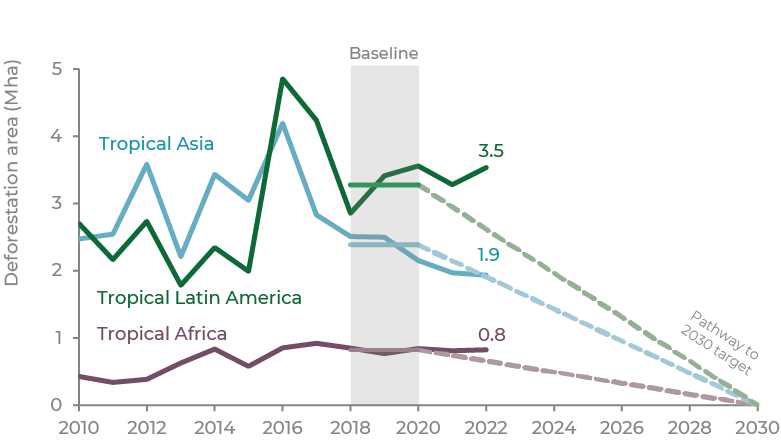In 2022, global progress on protecting and restoring forests moved too slowly and, in some cases, progress was reversed. Each year that passes without sufficient progress, it becomes more and more challenging to meet global forest goals by 2030. Progress in 2021 was already insufficient, and the world needed to make up that lost ground (and more) in 2022.
Findings
In 2022, 6.6 million hectares of deforestation occurred worldwide. That means that not only did the world miss its 2022 target for eliminating deforestation by the end of the decade, but there was a 4 percent increase in deforestation compared to 2021. Furthermore, gross emissions from deforestation increased by 6 percent compared to 2021 – totaling 4 billion metric tons of carbon dioxide equivalent in 2022.
Regional deforestation targets were missed in all tropical regions, though not to the same degree. Tropical Asia fared better than other tropical regions; it saw a 16 percent lower rate of deforestation in 2022 compared to baseline levels (see Figure). While this progress is still slightly too slow (as deforestation in the region was still 1 percent higher than the Assessment-identified target), it shines in comparison to Tropical Latin America and the Caribbean (LAC), which saw a 9 percent increase in deforestation compared to baseline. That means tropical LAC is the tropical region farthest off track from the pathway to 2030 (with 35 percent higher deforestation than the Assessment-identified target for 2022).
Notably, forest regrowth in tropical deforested areas has increased exponentially over the past four years, demonstrating the great capability of forests to recover from disturbances, but also signaling that at least a portion of deforested areas are abandoned after logging. Regrowth is certainly positive, but the ecological conditions characterizing mature forests may take decades to be reestablished. While there is evidence that restoration is scaling up globally, tracking progress is hindered by the glaring lack of transparency on public and private efforts to restore forests across the world. It is essential that both public and private sector actors step up to report their restoration data with a focus on quality, validation, and transparency.
| Figure: Tropical regional deforestation between 2010 and 2022, in million hectares |

How do we assess progress?
This chapter provides a summary of global progress on halting deforestation and degradation and advancing forest restoration. We estimate progress using several quantitative indicators. The Technical Annex provides the full list of indicators, which are divided among core and supplemental indicators. Core indicators pertain to the overarching targets on protecting and restoring forests. Supplemental indicators provide additional context on the state of forests through an estimate of forest carbon stocks and biodiversity within forests.
Core indicators:
Supplemental indicators:
The forest ecosystems that support a liveable climate, invaluable biodiversity, thriving economies, and intangible cultural importance remain under massive pressure. Standing forests are essential for limiting global warming to 1.5°C. Yet, the world remains off track to reach the 2030 goals of halting and reversing deforestation and forest degradation by 2030.
Through a comprehensive analysis across four main chapters-- Overarching forest goals (Theme 1), Sustainable production and development (Theme 2), Finance for forests (Theme 3), and Forest governance (Theme 4), along with 7 country case studies and a set of Recommendations—the 2023 Forest Declaration Assessment sheds light on the state of global forest action.




